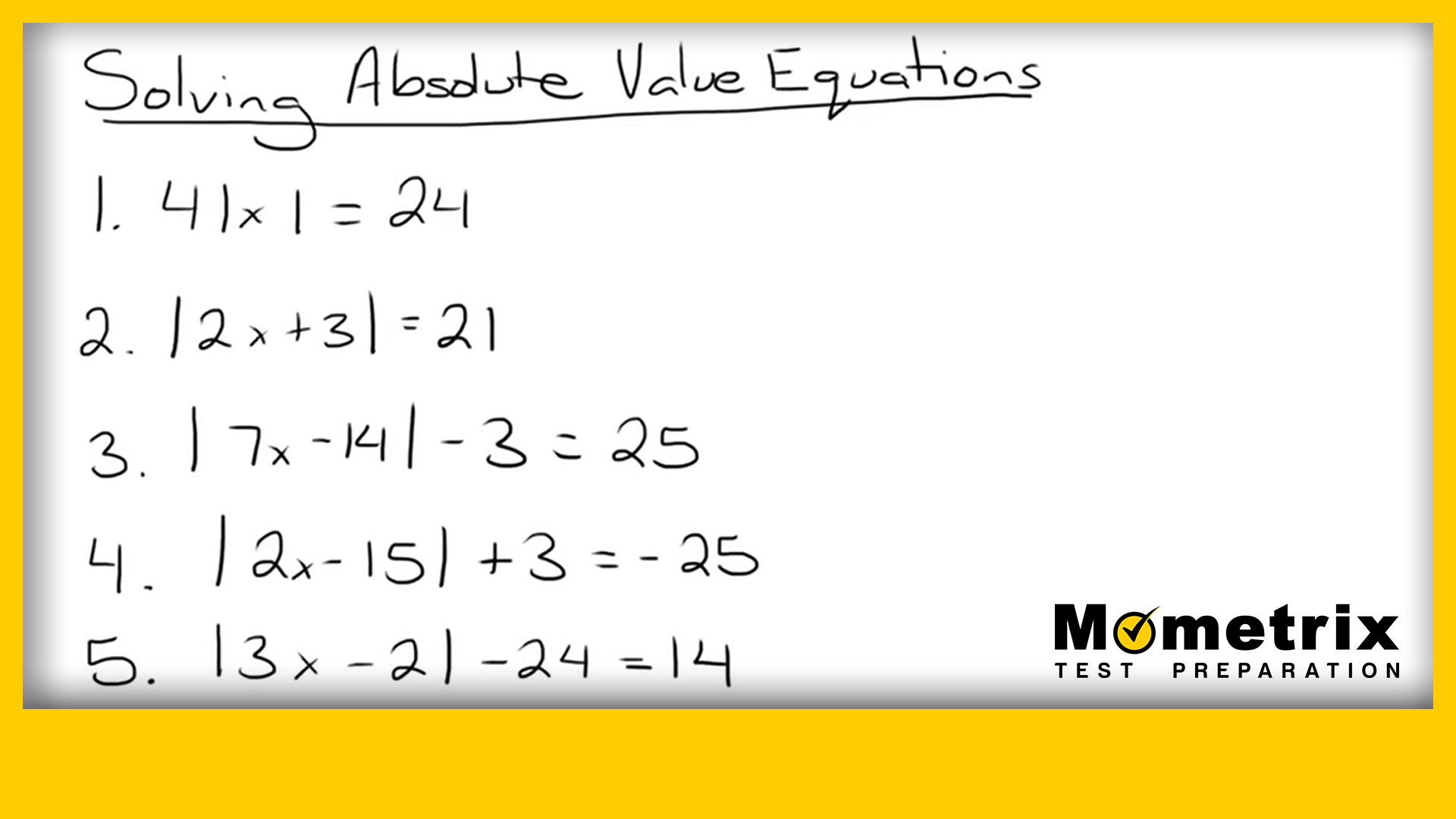
Hi, and welcome to this video on solving absolute value equations.
What is Absolute Value?
Before we get started, let’s review what absolute value is. The absolute value of a number is the distance that number is away from zero. In other words, you make any number positive. \(|27|=27\), but \(|-27|=27\) also. You make any number inside the absolute value signs positive.
When we solve absolute value equations, our process will look very similar to solving regular equations. There is however, one major difference. When solving absolute value equations, we need to consider when the expression inside the absolute value bars is positive and when it is negative.
Example #1
Let’s look at a few examples.
So we want to solve this for \(x\).
We’re going to start by dividing both sides of the equation by 4. The reason we do this is so that we can isolate our absolute value expression. You always want to isolate your absolute value part first.
\(|x|=6\)
Then, remember the definition of absolute value. The absolute value of a number is always positive, so \(x=\pm 6\) because if we take |6|, we’ll get 6, and if we take \(|-6|\), we’ll also get positive 6.
So that’s how we solve a simple absolute value equation.
Example #2
Let’s try another one.
This time we have an expression inside our absolute value bars, so we’re going to solve for \(x\) in a very similar way. However, we don’t have to get the absolute value expression by itself this time because it’s already isolated. So, we’re going to start by getting rid of the absolute value bars. Now, the way that we do this is we split our expression inside into two different equations.
We want to consider this to be a positive answer and consider this to be a negative answer. Remember, last time we had \(|x|=6\), and we knew that \(x=6\pm\). \(x\) was our expression inside the absolute value bars, and we set that equal to positive and negative of the answer. So we’re going to do the same thing.
We do this because the absolute value symbols make any answer positive, so the inside expression could actually be either positive or negative.
Now, all we do is solve both equations for \(x\). And since we have the same expressions on both sides, we’ll follow the same steps for both equations.
Since we are considering both a positive and a negative answer, we will get two different values of \(x\). Our solutions for this equation are \(x=9\) and \(x=-12\).
We can check them by plugging them into our original equation.
\(|2(-12)+3|=|-24+3|\)\(=|-21|=21\)
Example #3
Let’s try another one.
For this one, our first step needs to be to get the absolute value expression by itself. So we need to get rid of this minus 3. So to do that, we’ll add 3 to both sides of the equation.
\(|7x-14|=28\)
From here we split our equation into two different ones. Remember, we want to set our expression on the left equal to the positive and negative value of the right side. Then, we’re just going to solve both of our equations like we did last time.
So our answers for this equation are \(x=6\) and \(x=-2\).
Example #4
Let’s for a second consider one of the problems we might encounter when working with these equations. Take a look at this example:
The first thing we would do in this example is subtract 3 from both sides, but when we do that, we get this:
\(|2x-15|=-28\)
What’s wrong with this equation? Well, we know that absolute value signs always make a number positive, so it is not possible to have an absolute value expression equal to a negative number. If you ever encounter this, just know that it means there are no solutions to the equation. So if you get a negative number on the right side, when there’s an absolute value expression on the left, this means there are no solutions.
Example #5
Before we go, I want to work through one more example.
So we’re going to solve this just like we have been. Start by adding 24 to both sides.
\(|3x-2|=38\)
Now, we get rid of the absolute value symbols and split our equation into two different ones.
Finally, we solve both equations for \(x\).
So, our answers are \(x=\frac{40}{3}\) and \(x=-12\). Don’t be afraid by this fraction right here, you can just leave it just like this—so your answer is, \(x=\frac{40}{3}\), and that is correct. So the solutions for this equation again are \(x=\frac{40}{3}\) and \(x=-12\).
I hope this review on solving absolute value equations was helpful. Thanks for watching and happy studying!

